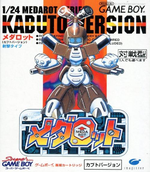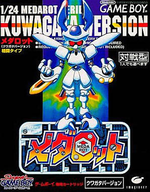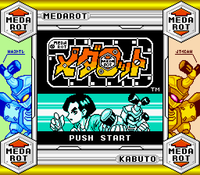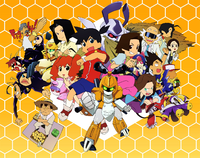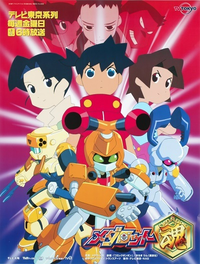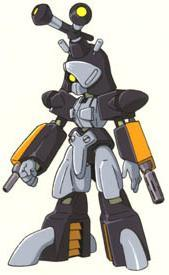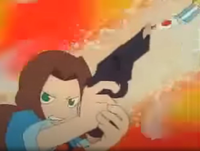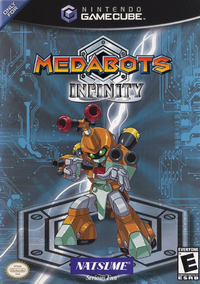The 'Shroom:Issue 200/All's Fair In Love and Robattle
Nostalgia is a funny thing. Sometimes you go back to something you enjoyed as a child and find it to be piddling, tired stuff designed to push plastic crap to kids. Other times it's not that good or not that bad but you still enjoy it as a forgivably flawed memento of the past. Often, it's not about the thing itself as much as it reminding you of simpler times.
It doesn't always have to be this way though. Sometimes you go back to a thing you remember and it's not just as good as you remember it, it's so much better and there's a lot more of it than you thought. This is what happened when I took a look at a show I faintly remembered liking as an eight-year old, and walked away with a new obsession. This is the story of *drumroll* Medabots, and really what better tribune than the Super Mario Wiki's community newspaper?
Wait, it was a video game first?
By 1997, the Pokémon craze was still sweeping Japan and its prolonged success made it obvious there was a lot of money to be made with the monster collecting genre. Imagineer, a small publisher then mostly known for bringing western computer games to Japan, got a brilliant idea: what if we took that concept but made it about the one thing kids like more than disease vector rodents, robots? To that end, the company hired veteran game company Natsume to make the game and Horuma Rin, a young artist just fresh out of manga school, to design the robots and nail down the basics of the story and setting. Thus came Medarot, released in November 1997 for the original Game Boy.
The game was a decent success, and since its inception more than 25 years ago, Medabots (or Medarot as it's known in Japan) has seen dozen of games in the RPG and action genres, and has seen a smorgasbord of tie-ins in other medias including two anime series, multiple mangas, physical merch and even its own official vtuber channel. In mons tradition, most of the games come in two versions, Kabuto (Metabee) and Kuwagata (Rokusho) with a different starting robot and parts that will require trading between players if you want to get everything. Early releases also got supplementary "Parts Collection" games – short, plot-light expansions that gave players who couldn't use the link feature another way to collect all parts. How sneaky!
This is not to say Medarot is a creatively-bankrupt cash-in on a fad, because there's plenty to like about the game. The battle system (as I'll elaborate below) is complex and interesting. The Medabots themselves are an appealing bunch, running the whole gamut from cool, cute, and creepy. The game is pretty meaty, with a reasonably large map and tons of sidequests and secrets to claim for those who care to explore it. There's even branching endings depending on seemingly minor choices made throughout the story. It's clear there was a real passion and drive behind the game, and it's only made all the more impressive by the fact that, according to the game's scenario writer and graphic designer, she was only one of three people to work on it.
What makes Medabots interesting?
Medabots takes place in a world much like our own, except kids are given unsupervised access to sentient robots equipped with real bullets, swords, and missiles as is prudent to do. The titular Medabots are one meter-tall robots built around a generic frame (called "Tinpet") and modular in nature, being able to freely swap their arms, legs, and head in any combination. Their names come from their medals, which hold the Medabot's personality and memories and dictate what stats it specializes at and what parts they prioritize when attacking.
Because yes as it turns out, Medabots love to Robattle and tradition dictates the loser of a bout surrenders one of their parts to the victor. For the purpose of gameplay, Robattles are visualized as kind of a relay race: your Medabots start on the left of the screen. You give them their orders and they'll waddle to the right of the screen, execute their command, and then run back to the starting point, rinse and repeat until the leader of the opposite Medabots team is taken down and your Medabot's untameable thirst for blood is, temporarily, quenched.
Sounds like typical RPG stuff, but there are lot of systems that make Medabots's gameplay worth taking a look at:
- The Medabots are customizable: though all models have a complete set, you can swap their head, left and right arms (arms can be asymmetric), and legs, with the only restriction being that male parts cannot be put on a female Tinpet and vice-versa. Like a Medabot's kit but think its legs are a little too squishy? Then just give it tankier legs – it may not look pretty, but it'll work. Or you can disregard fashion entirely and make abominations that let you stack whatever abilities and stats you want.
- The medal system adds an interesting wrinkle to the building of one's Medabots: do I pick a medal that is strongly specialized in one thing or a less specialized medal that is decent at more things? Do I pick the medal that prefers to target the most armoured part or the one that prioritizes hitting the legs? It's not just a small stat boost – an otherwise excellent Medabot will not be able to hit the broad side of a barn without the proper medal.
- What you start with is what you get: there are no items you can use to replenish your Medabot's health or clear its status ailments, and though a small number of Medabots can perform healing or inflict status effects, they're highly specialized in those tasks. You always enter your battles at maximum health and ammo capacity. This, and the fact that the sole objective of a Robattle is to take out the enemy leader, opens up a lot of tactical possibilities: making one or more of your Medabots a "support boat" is especially viable here, as are tactics like kitting out a Medabot purely to self-destruct and take its opponent out with it.
There's some randomization here so the outcome of a Robattle is never fully predictable. Sometimes you might take out the head of the opponent's leader in a single blow and net an upset win. Conversely, the enemy might take out your support Medabots early, turning an even 3v3 into an uphill 2v3. It's complex and skill-based enough to be interesting, but unpredictable enough to keep you on your toes.
Of course a truly great game is more than an interesting battle system. The games are decently long and challenging without being insurmountable, the music and graphics are great (the battle theme is iconic) and the writing is effortlessly funny and charming. In short, they're good RPGs for kids and adults!
The anime
Though the Medarot 1 and Medarot 2 mangas got releases in some European countries and Singapore, the reason most people outside Japan heard of Medabots was its anime adaptation. Drawing from the basic story and characters of Medarot 2 (with many elements from the first Medarot thrown in), the series was produced by Bee Train, a studio devoted to nurturing up-and-coming talents. The Medabots anime aired from 1999-2000 on TV Tokyo and got exported by Nelvana for western consumption in 2001.
The story stars Ikki Tenryou, a young boy who loves Medabots but can't afford one. Through a series of events, he gets possession of a rare and powerful Kabuto medal and the body of an obsolete Medabot called Metabee. Metabee soon proves to be surprisingly fearsome… but Metabee is not like other Medabots. He's rude, hot-headed, disobedient, and all-around a horrible little metal man. What follows is a series of episodic stories as the two get in hijinks and foil the schemes of an amusing inept gang of troublemakers called the RubberRobo gang. In time though, the story weaves in a number of plot threads including the preparations for the upcoming World Robattle Tournament, the antics of the master thief Phantom Renegade who definitely isn't the local friendly convenience store cashier, the mysterious wandering Medabot Rokusho and his search for his missing master, the RubberRobo gang's sinister scheme for world domination, and even the cosmic origin of the Medabots themselves.
Medabots is an amazing show. Much has been written about its production staff being jam-packed with people who would soon become legends in the industry, and the sheer caliber of talent behind it is evident in all aspects of productions. Even though working on a low-budget videogame tie-in would be an excuse to slack off, the production didn't. The Medabots are wonderfully expressive, even though none of them have mouths or even noses. There was a lot of thought in making them move in a believable way, something even the artist of the games praised. There are some gorgeous battles in there and even when robots are fighting, there's tons of funny expressions and little flourishes to latch onto. It's ultimately a low-budget kids show and that shows in things like some rather economical scenes of characters standing and talking and (mercifully brief) stock footage, but it truly exemplifies the anime ideal of doing more with less.
It's also just really funny television. The relationship between Ikki and Metabee is precious - they constantly bicker and trade some creative insults but feel totally believable as friends. The villain's plans are hysterical: one early episode has them start up a fake zoo where exhibits are played by penguins in costumes, and another has them do creative urban renovation by rebuilding houses in all sorts of weird shapes. Showing a true commitment to the gag, one of the last episode shows one of the main character still lives in the fucked-up Tengu head her house got turned into in that earlier episode.
Speaking of commitment, it's impossible to not mention the show's best and most important character: Mr. Referee! A normal TV show would just have the characters follow a gentleman's agreement when Robattling or perhaps do it in some formal arena setting, but Medabots isn't a normal TV show. Every Robattle in Japan is thus arbitered by the same middle-aged man - doesn't matter if it's on the school's playground, the roof of a burning building or a secret underground facility, Mr. Referee will be there and he'll make sure the rules of combat are scrupulously followed. The gag gets escalated, played with and subverted countless times throughout the series and it never gets old. If we all cared about our job as much as Mr. Referee cares about the sanctity of toy robot battles, the world would be a much better place.
Beyond action and humour though, Medabots has a real heart, and it's embodied in my favourite of its characters, Kikuhime (or Samantha as she's called in the English dub). Kikuhime starts as the head of a local gang of bullies and occasional pest and while her outrageous actions and unearned arrogance already made her entertaining enough on a surface level, it's made obvious there's more to her than meets the eyes: she takes up ballerina class, gives a motivational speech to an underling who's sunken deep into depression after his Medabot deserted him, and even falls in love. In my favourite episode of the show ("For Love or Robattle"), she tries to swoon her crush (in a lovably clueless "This is what people in love do, right?" way) but when he reveals he hates Medabots and their owners, poor Kikuhime feels forced to abandon her beloved Peppercat, and it all builds up to an electrifying conclusion that I won't spoil. It's funny, heartfelt and action-packed in equal measures and a great display of the show's dedication to fleshing out its charming cast – I feel calling them three-dimensional is a smidge overselling it, but they truly feel like people and not just archetypes that are there because they're expected.
It's not perfect. Some plot points in the episodic stories are half-formed. The writers were maybe too comfortable having the later battles be solved through Dragon Ball Z-style power attacks. It doesn't take advantage of the source material's concept of swapping parts and making your own Medabot as much as you'd think it would. Really though, I'm just grasping at straws. I can't gush about it enough. It's smart, funny, engaging and even when it gets all dark and serious, it never forgets to be fun. I think it's a testament to its excellence that even though nothing Medabots has been released outside Japan since 2004, people still remember it fondly largely off the back of how good the show is, while nobody gives a shit about, say, Chaotics today.
The other anime
With the first series being a big success, they wouldn't leave it there, and indeed Medabots Spirits followed a whole week later. Adapting (loosely) Medarot 3 and Medarot 4, Spirits was handled by another studio called Trans Arts and was so famously unpopular when it aired that one of the producers had to make a statement on the show's website apologizing for it. It wasn't much better-received when it aired as "season 3" of the series in western markets, and while there are some willing to concede it had its moments, it's hardly seen a comprehensive Star Wars prequels-style movement to reframe it as an unfairly-maligned masterpiece. So from the onset, one might be tempted to ask: is Medabots Spirits that bad?
I don't think it is! But I also don't begrude anyone who hates it. It's complicated really.
The plot of Spirits starts when a new robot manufacturer enters the scene with a dastardly new product: Kilobots, Medabots who have their emotional component removed in exchange for increased attack power and who allow their owner to circumvent the rules of Robattle in various ways. Hawking these nasty wares is one Kam Kamizake, child prodigy and evil little shit who'd love to see all Medabots go to the big junkyard in the sky. With some help from doting mechanic Ms. Nae, Ikki and Metabee naturally won't stand for this and uhhhh that's pretty much it. There's some subplots but no real throughline until the last dozen of episodes, with the story mostly consisting of "Monsters of the week" - plots and stories where Kam hatches some evil scheme to destroy or discredit Ikki and Metabee, doing so multiple times until it blows up extra hard.
The show makes its main themes friendship and teamwork. You know it because, especially early-on, new character Nae is prone to making speeches explaining that Medabots are FRENS and have SOVL and the Kilobots are bad because they don't have a SOVL and cannot be FRENS. Yeah, I know there's an inevitable degree of cringe in a nearly 30-year old man criticizing a show made for babies for not being highbrow enough for my sophisticated manchild mind – but I mean, the original show approached those themes with more subtlety. I don't think it's an unfair criticism.
The one thing people focus on when discussing Spirits is that it drops large chunks of the supporting cast. The main character's rival? Gone. His love interest? Also gone. Mr. Referee? M.I.A. There's not even a handwave, a "Mr. Referee died on the way back to his home planet" to explain their absences, it's like they never existed. Beyond unpersoning characters, the show also plays fast and loose with the setting. The games and previous anime clearly established a Medabot's medal is what holds its soul, but in many instances the writers of Spirits seemed to think otherwise. An infamous scene in the second episode has the bad guys destroy a bunch of kid's medals (picture a Pokémon show where Team Rocket straight-up kills Pokémon) and nobody really cares. Conversely, when Metabee's body appears to have been destroyed in a later episode, Ikki acts as his friend is dead even though he's holding his medal and could simply put him in another body. The previous show had many adults using Medabots and Medabots being used for non-combat tasks, but here it's purely a kids thing, so much that one episode's plot hinges on a guy being seen as a creep and weirdo for Robattling as an adult. It's not a reboot – the show expects you to be familiar with the characters and their relationships and occasional references are made to the finale of the previous series - but there's a lot of little discontinuities like this and they all make obvious Spirits was produced by a completely different crew who seemingly were not briefed on what the previous guys were doing until it was too late to correct course.
The other sticking point is the animation. Remember when I talked about how cool and impressive the fight scenes in the original show were? Well forget all of that because Spirits trades it for some mighty dull and uninspired battles, often consisting of opponents standing and trading blows. There's some ugly frameskipping and some fights don't even look like they were storyboarded. The third episode in particular has a truly lamentable fight that would make the lamest Filmation cartoons die of secondhand embarrassment. Now to be fair, some individual episodes are well-animated and the baseline animation quality does improve after the series switches to digital ink and paint midway through its run, but rarely it is impressive or worth praising.
I'm making Spirits sound like pretty darned dreadful, but while it undeniably starts out rough, like your teenage acne scarring or your post-breakup blues, It Gets Better™. Individual moments show flashes of the humour and charming characters you loved, Ms. Nae evolves from a walking plot device to a truly lovable and well-rounded character, and slowly but surely Spirits finds its groove, with its own stories and characters worth caring about. It's not a completely uniform improvement in quality as there's still a handful of bad episodes after it "gets good", but this is one of those shows that gets much better in its back half.
One part of it worth highlighting is the character of Ginkai. Introduced as Kam's primary henchman and a one-dimensional jerkass, guy eventually has a change of heart and through a series of events, becomes one of the good guys… Okay I'm making it sound like the most generic thing ever, and it's a common plotline for this kind of show, but it's done well here and Ginkai remains a compelling character following his redemption thanks to his rough 'tude and his endearing relationship with his Medabot Arc-Dash, who's just a riot to watch. Another great character is Blackbeetle (the 3edgy5me Metabee you see to the right) who is both an effective villain and a tragic figure. There are some great standalone stories here too. One episode tackles the question of what happens to Medabots when their owners grow out of them. Another has Ms. Nae attend a high school reunion and get chided by her old friends for "losing her feminity", leading to a story where she shows a friend a typical day at work and why she's so heavily invested in being a good role model for children. It's pretty unexpected subject matter for a kid's videogame tie-in to tackle, and it doesn't talk down to its audience in doing so.
So yeah that's Medabots Spirits. It starts rough and its flaws are hard to forgive, but by the end I loved it, warts and all, and accept it as a sequel. At the very least, nobody can accuse it of being a rehash.
Their dub
The late 90s and 2000s saw many distributors hitch their wagon to the anime gold rush, and Canadian company Nelvana would be one of them, dubbing both series as one continuous show from 2001 to 2004. It's very typical of anime dubs of the time: dialogue is substantially rewritten and sometimes made up entirely. The entire soundtrack is thrown and replaced (shout-outs to the new opening, that shit's tight). Many characters' names are changed and references to Japanese culture are simplified or removed. There is a lot of "filling dead air" - having characters blabber from off-screen and playing music in scenes that were originally silent[1]. There are a lot of small edits to account for different runtimes, etc. The changes are not as extensive as the likes of 4Kids's Pokémon or Saban's Digimon but it's very much cut from that cloth.
The episode order for the first anime was infamously messed up in the dub, with only the first five episodes and last 13 matching the Japanese order. The story as I understand is that Nelvana wanted to dub all 52 episodes but the network only committed to 26 episodes at first. As a result, most of the early "filler" episodes are skipped over to rush to the first climatic story arc, but when the show was renewed; they went back and dubbed the previously-unaired episodes. It's just a mess: characters that were written out come back randomly, references are made to events that were skipped over, foreshadowing for events that already happened is kept in, and so on. There's some minor dialogue change to account for this, but you can't write around that much, and as a result the English dub makes much more sense when watched in the original episode order.
There's also some censorship. The original show was tame to begin with so it's not story breaking (mostly cutting scenes of people slapping each other) but the sequel's ever so slightly edgier nature caused more issues. One early episode has an entire minute repeated to replace what was cut and one episode was rewritten in a nonsensical mess because in one actor's words, "we couldn't show a younger girl hanging out with an older guy". The final episode of both series also had custom ending sequences which were removed from the dubbed versions. Again this is not story-breaking for the first anime (mostly different slides in the ending credit tying up minor loose ends and explaining why one character doesn't appear in Spirits) but it really hurts Spirits's finale, which had a whole minute of original animation to answer a dangling question and give one final appearance to characters who had sat out of the final stretch of episodes. The American finale (consisting of a character narrating over stock footage of the series's recurring characters) feels abrupt and downbeat where the Japanese finale is a good enough closer.
The voice acting ranges from good to terrible, primary characters mostly sound decent and get better as the show progress, but some background and one-off characters sound like joke voices you'd do drunk at a party. A highlight is Metabee's voice who provides a different take from the Japanese actress but one that ultimately stays true to the spirit of the character – he plays him as a kid-friendly Bender "Bending" Rodriguez and it's great. Overall I'd say the Japanese original is superior, but the dub doesn't turn a good show into a bad one.
Sounds neat! How do I get into Medabots?
Why yes nonexistent person, I'm so glad you asked!
For the animes, it's quite easy: just go on YouTube! The first 26 episodes of the English dub are on the people's streaming service Tubi if you want subtitles, and both anime series also have been officially released by boutique anime distributor Discotek on Blu-Ray (both dub and sub), with the subtitled release of Medabot Spirits recently announced but TBA. That one is of special interest as the show has yet to be fully fansubbed into English.
For the games, it's a bit more complicated. Only three Medabots games have been officially exported, all to tie into the early 2000s popularity of the anime:
- Medabots: An RPG Adventure (GBA, 2003): The only mainline game to see release and a better remake of Medarot 2 with some changes to better integrate with the first anime. A cracking little RPG and the best intro to the series for the unitiated.
- Medabots AX (GBA , 2003): A passable but somewhat shallow and janky Smash Bros. clone.
- Medabots Infinity (Gamecube, 2004): A boring, plodding, and ugly overhead shooter/dungeon crawler thing. Just awful. With the GameCube having much better "toy robots" games in Gotcha Force and Custom Robo, there's no reason to play this.
1/3 isn't a great battering average, but niche fandoms attract dedicated individuals and since the late 10s there's been movement to make the series more available outside Japan. As such, if one is willing to consider the world of fan-translations…
- The original Medarot got English and Spanish fanslations in 2020 (IPS patches for the Metabee version downloadable here). It can't quite escape being a GameBoy RPG built on the sweat and tears of three developers, but it's a fun time! (PROTIP: Set the Battle animations to "fast" and don't be afraid to use this guide)
- Medarot R (1999, PS1) got an English translation from a separate group. It's an RPG telling a similar but distinct story from Medarot 2, and is notable for both being the first 3D game in the franchise and its gargantuan roster of Medabots (253!). The writing is a little dry compared to the mainline games and the high random encounter rate combined with the slower pace of battles can make one insane, but there's a decent little RPG in there.
- Medarot 3 (2000, GBC) has an in-progress translation by the group behind the Medarot 1 fantranslation. (ips patch downloadable from the project's github page here. Currently it's considered to be at 100% text done (everything is translated except for the text when using the GameBoy Link Cable) although that does not mean it is complete as it still needs to be fully copy-edited and checked for context. Even with the translation not being fully done, I would recommend this as the best Medabots game for beginners. The galling unbalances from the previous games are fixed, its production values are excellent for a Game Boy Colour game and the writers really find their groove here – it's laugh-out funny at several points. It's a great counter to the (not unfounded) idea that the GBC was where bad kiddie licensed games went to die.
NFT (Not the Fucking Trademark!)
Man, that Medabots shit sure was tight huh? I wonder what they're doing with it now… Oh there's a game on my iPhone? Let me check what it's about…
- “Welcome to Medabots, the official sub-reddit for the upcoming crypto P2E strategic robo-battler. ”
- —The subreddit description
The story is wild and lengthy and this post does a better job at summarizing it than I ever could. The short version is that Imagineer let the European trademark for Medabots lapse and a Spanish guy bought it, making his scam-tastic NFT Crypto mobile game with art and mechanics clearly derivative of the IP. A lawsuit ensued in 2020 when the guy sued Imagineer for trying to commercialize the real Medabots games in Europe and the series status in the west has been held up ever since then.
Also they had the actors for the Mexican cartel twins in Breaking Bad shill the associated cryptocurrency. It isn't really crucial to understand the story but it is pretty fucking funny.
Fortunately, the system sometimes works and the case saw a big breakthough in September of this year as Spanish courts ruled in favour of Imagineer. We're not entirely out of the woods as there is still time for the other party to appeal to the Supreme Court, but this seems unlikely to change the judgment.
The state of the Meda-Union
The main attraction since 2020 has been Medarot S: Unlimited Nova. It's a mobile game that pulls from all over the series' long history and I assume it must be modestly popular since it's still getting updated every week. Dedicated players will tell you it's the deepest, most balanced and content-packed game yet but it's also a Gacha game, with all that implies in terms of structure and monetization.
Almost more notable than the game itself is its collaboration: crossover events are a gacha tradition but throughout its 3 years run Medarot S has managed to get big ticket events going with properties as varied as Neon Genesis Evangelion, Fullmetal Alchemist, Ultraman, Mega Man Battle Network, Ghost in the Shell, Zoids, and even Transformers. One has to wonder if Medabots is popular in the industry or if someone at Imagineer has compromising photos of licensing agents everywhere at a crack-snorting party.
The game does have a small but dedicated western playerbase. There's a diligently maintained fan wiki with comprehensive information on the game and guides on how to play it and install it on your phone (nothing difficult or illegal, I reassure you). If that's not enough, there's a supremely dedicated Youtuber who's done overviews of every single playable Medabot and their kits. So if you're interested in playing it, you have all the resources to do so.
Final thoughts
August of this year saw the release of Armored Core VI: Fires of Rubicon. It's an amazing game even if I don't gel with all of the design choices made, and it's (apologies to Gordon Ramsay) a fresh… modern… vibrant… take on Armored Core. Its considerable success is noteworthy not only because Armored Core was incredibly niche before, but it had been ten years since its previous installment. And it makes me think… could Medabots have a similar breakthrough?
It's not a perfect comparison: Imagineer is a much smaller company than From Software and it hasn't build up a fanatical following over the previous decade by making consistently excellent games (even if its Fitness Boxing games have been very successful). On the other hand, I would argue Medabots is more recognizable than what Armored Core was previously… and I think that on some level, even with the very different tone and gameplay, VI's success shows there's a certain pent-up demand for games about customizable robots, as long as they're done well and marketed right.
2024 could prove to be an interesting year for Medabots. The trademark lawsuit might make Imagineer more open to asserting its IP ownership worldwide, and the year will also mark the 25th anniversary of Medarot 2 and the anime. Seems like a good time for an announcement, but you never know.
I don't know if Medabots can ever truly return to be a big mainstream thing but at the very least it deserves to be enjoyed – and accessible - worldwide. My own experiences and the sheer passion and creativity I've seen from the fanbase have convinced me there is something special about these robots, and I hope this humble writeup at least conveyed some of that to you.
